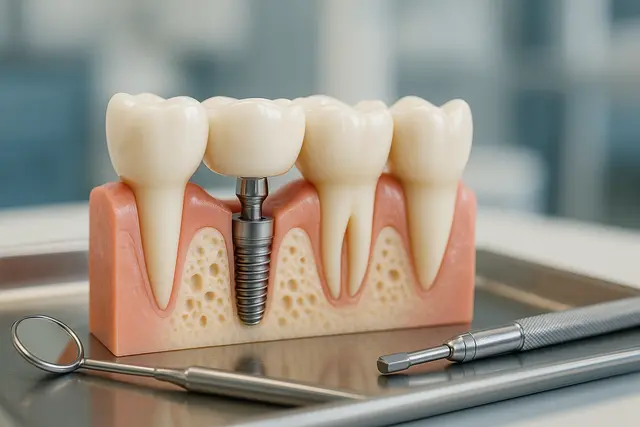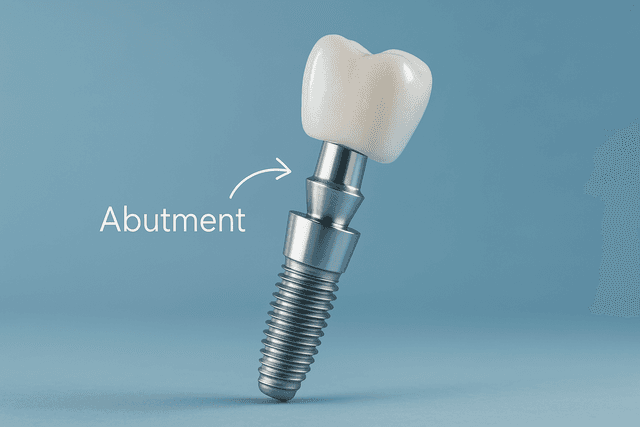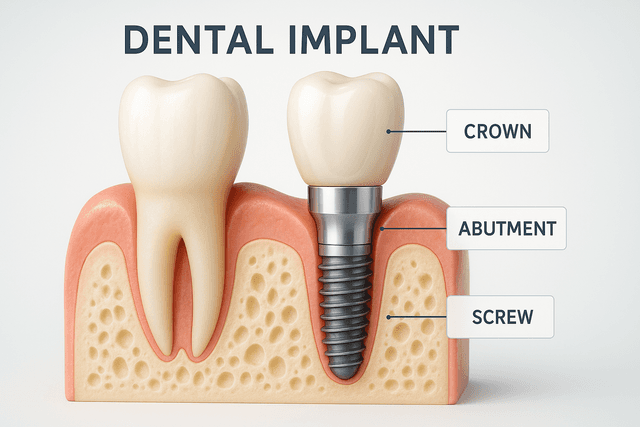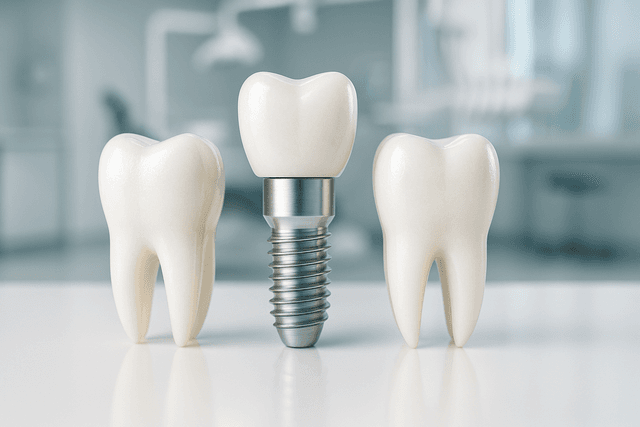Prosthodontics
6 min read
Oct 10, 2025
Pros and Cons of Implant Retained Bridges: A Simple, Honest Overview
Missing teeth can affect more than just your smile, they can impact your confidence, speech, and even how you eat. With so many options out there, it’s easy to feel lost in dental jargon and marketing buzzwords. That’s why we’re breaking down implant retained bridges in plain English, highlighting the pros and cons so you can make an informed choice without the fluff.

Let’s be real. If you’re dealing with a missing tooth or multiple missing teeth, the options can feel overwhelming. You're trying to figure out what’s best for your smile, your wallet, and your sanity. And if someone says "dental bridge" or "implant" one more time without explaining it clearly, you're going to scream.
So let’s slow it down, cut the fluff, and talk like real people. This is your no-nonsense, slightly humorous guide to the pros and cons of implant-supported dental bridges. We’ll cover what they are, how they stack up against a traditional dental bridge, what getting a dental implant is actually like, and what your dentist might not tell you unless you ask.
What Is a Dental Bridge and Why Should You Care
A dental bridge is a way to replace missing teeth by literally bridging the gap between teeth. It’s one of the most common tooth replacement methods out there. The bridge itself usually consists of one or more artificial teeth that are held in place by dental crowns on the teeth on either side of the gap. Those teeth are called abutment teeth. Classic teamwork.
Now, a dental bridge could be supported in two main ways: by your natural teeth (that’s a traditional dental bridge) or by implants. And that’s where the game changes.
Traditional Bridge Explained Without the Jargon
Let’s say you lost one tooth. A traditional dental bridge would shave down the healthy teeth on both sides to place crowns that hold the bridge in place. So yes, you get your smile back, but at the cost of touching teeth that were perfectly fine before.
Traditional bridges are typically faster to get and less expensive upfront. Bridges typically last between 5 to 15 years depending on how well you care for them. Regular dental check-ups help keep them in good shape, but still, they may need replacing eventually.
The big win? You’re back to chewing and smiling fairly quickly. The downside? You sacrificed two natural teeth for one artificial one.
The Rise of Implant Retained Bridges
Enter the implant-supported dental bridge. Instead of relying on natural teeth for support, this type of bridge is held in place by dental implants. Implants are artificial tooth roots (think titanium magic screws) that go into your jawbone and support the bridge like natural tooth roots would.
Here’s where things get fun. If you’re missing several teeth in a row, instead of needing a full implant for each missing tooth (which would cost a small fortune), an implant-supported bridge might use just two implants to hold several artificial teeth.
That means less drilling, more stability, and no damage to your healthy teeth.
Pros and Cons of Implant-Supported
Alright, now we’re getting into the juicy part. Let’s break down the pros and cons of implant-supported dental bridges without sounding like a brochure.
Pro: Keeps Your Natural Teeth Safe
Unlike a traditional bridge, you don’t need to mess with the teeth on either side. Your natural teeth stay untouched. That’s a win in anyone’s book.
Pro: Feels Like the Real Deal
Implants stimulate your jawbone just like natural tooth roots, which keeps it from shrinking over time. The result? A stronger bite and a more youthful-looking face. Yep, really.
Pro: Long-Term Solution
Implants can last a lifetime if you care for them right. The bridge on top might eventually need replacing, but the implant itself? Rock solid. Compared to bridges, implants tend to have a higher success rate in the long run.
Pro: Good for Multiple Missing Teeth
If you're missing three or more teeth in a row, this is a fantastic treatment option. An implant-supported bridge can do the job of replacing multiple missing teeth without needing an implant per tooth. Less hardware, same function.
Con: Higher Upfront Cost
Let’s not sugarcoat it. The upfront cost of implant-supported bridges is higher. Between surgery, materials, and time, the bill adds up quickly. But remember, this isn’t a “cheap now, fix later” situation. It’s a long-term investment.
Con: Longer Treatment
We’re talking months, not days. Healing after an implant is placed can take 3 to 6 months before the bridge is added. So if you’re in a rush to flash that smile, this might test your patience.
Pros and Cons of Traditional
If you're still on the fence, let’s run through the pros and cons of traditional bridges so you can compare apples to apples.
Pro: Fast and Budget-Friendly
Traditional bridges are quicker to place and cost less upfront. If you need something sooner rather than later, this might be your go-to.
Con: Damage to Healthy Teeth
One of the biggest drawbacks is that it requires shaving down adjacent teeth for support. These were perfectly healthy teeth, and now they're part of the bridge club. Not ideal.
Con: Doesn’t Prevent Bone Loss
Since there's no implant to mimic the tooth root, your jawbone underneath can start to shrink. This can change how your face looks over time and affect future dental work.
Getting a Dental Implant Is a Journey, Not a Quick Fix
If you're thinking about getting a dental implant, know that it’s a process. First comes the evaluation. Not everyone is a candidate for dental implants, especially if you've lost a lot of bone in your jaw. Then there's the surgery where the implant is placed. After that? Healing time.
But if everything goes well, you end up with something that acts and feels just like a real tooth. One that can handle a steak or a crunchy apple like a champ.
Advantages of Implant-Supported Bridges You’ll Actually Notice
Let’s say you go for implant-supported dental bridges. What’s life like afterward?
You’ll notice that they feel stable, even when you chew.
You don’t have to worry about them slipping around like dentures.
They look like your natural teeth and you don’t have to avoid foods you love.
No more worrying that your jaw is shrinking underneath.
Those implants are holding things down like a boss.
The Dental Bridge vs Implant Debate Settled
The dental bridge vs implant debate really comes down to your specific case. If you're replacing one tooth and your adjacent teeth already have crowns, a traditional bridge might actually make sense. But if your adjacent teeth are healthy, why file them down?
When replacing multiple missing teeth, implant-supported bridges give you the best of both worlds: fewer implants, strong function, and preserved bone. Plus, no guilt about touching perfectly good teeth.
The True Cost of Dental Implants vs Bridges
Here’s the money talk. Dental bridge costs are lower up front. A dental bridge consists of the crowns and the artificial tooth (or teeth) between them. Simple.
Dental implants involve surgery, imaging, lab work, and healing time. So yes, it’s a higher initial cost. But bridges may need replacing in 10 years, while implants can last a lifetime.
So ask yourself this: are you thinking short-term or long-term?
What Type of Bridge Is Right for You
If you're not sure which type of bridge is right for you, consider your priorities. Want fast and cheaper? Traditional might be your match. Looking for stability, long-term results, and saving your healthy teeth? Then implant-supported wins the day.
Think about how many teeth you’re replacing, how healthy your adjacent teeth are, and whether you’re okay with a longer treatment for better long-term results.
What Is the Difference Between a Traditional Bridge and an Implant-Supported Bridge?
A traditional bridge relies on natural teeth on either side of the gap to anchor the artificial tooth, requiring those healthy teeth to be filed down for crowns. An implant-supported bridge, on the other hand, uses dental implants surgically placed in the jawbone to support the bridge, leaving adjacent natural teeth untouched. While traditional bridges are faster and less expensive initially, implant-supported options offer better long-term stability and preserve bone health.
What Are the Main Advantages of Implant-Supported Bridges?
Implant-supported bridges protect surrounding natural teeth, maintain jawbone density by mimicking natural tooth roots, and offer greater stability when chewing or speaking. They’re ideal for replacing multiple teeth without needing an implant for each one, making them a durable, functional, and bone-friendly solution. Over time, they can be more cost-effective due to their longevity and fewer complications.
Are There Any Downsides to Implant-Supported Bridges?
The biggest drawbacks include a higher upfront cost and a longer treatment timeline due to surgical placement and healing. Patients may need 3–6 months of healing before the bridge can be attached. Some individuals may also require additional procedures, like bone grafting, to qualify for implants. However, many patients find these trade-offs worthwhile for the long-term benefits.
How Do I Know If Implant-Supported Bridges Are Right for Me?
You’re a good candidate if you’re missing multiple teeth, have healthy gums, and have enough bone density to support implants (or are open to bone grafting). If preserving natural teeth and long-term durability are top priorities, and you're okay with a longer treatment period, implant-supported bridges may be the better fit. A consultation with your dentist or implant specialist can help you make the best choice based on your oral health and goals.
Read Next
Related Posts

Prosthodontics
Implant Abutment Explained: What It Is and Why It Matters
Dental implants have revolutionized the way we restore missing teeth, but there's more to them than just the visible crown. One often-overlooked component, the implant abutment, plays a crucial role in both the function and appearance of the final result. Understanding what it is and why it matters can make all the difference in your implant journey.
4 min read
Oct 10, 2025

Prosthodontics
Implant Abutment Screw Explained: Function, Types, and Placement
Dental implants have revolutionized the way we restore missing teeth, but beyond the visible crown lies a small yet essential component that ensures everything stays firmly in place: the implant abutment screw. Understanding its function, placement, and types is key to appreciating the science and precision behind a successful implant.
5 min read
Oct 10, 2025

Prosthodontics
Implant Crown Lifespan: What to Expect Over Time
Getting a dental implant crown is a big step toward restoring both function and confidence in your smile. But like any dental work, it's natural to wonder how long it will actually hold up. From materials and maintenance to daily habits, several factors play a role in how long your implant crown will last.
4 min read
Oct 10, 2025
Don’t have time to research every dentist around you?
See why 30k+ patients trusted us